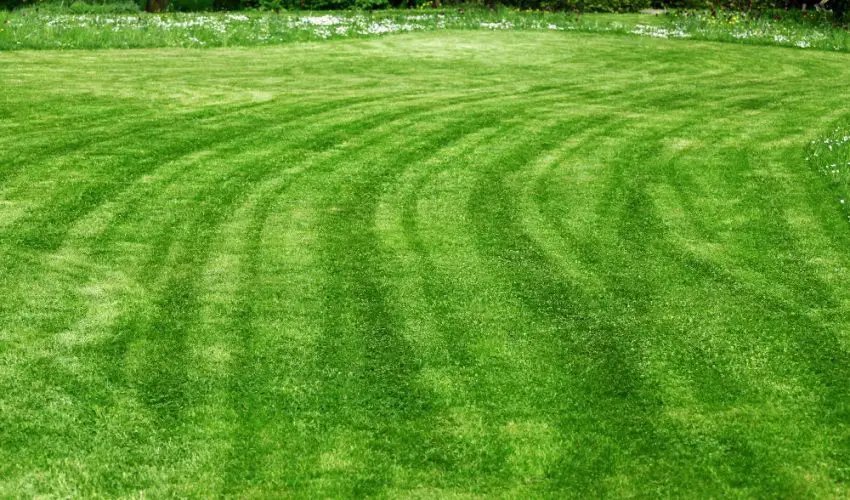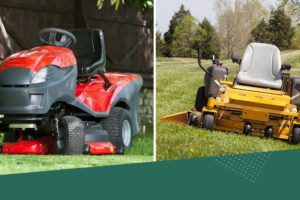1. Dull Blades or Damaged Blades
Dull or damaged blades are a top reason why lawn mowers leave cut grass behind. When blades aren’t sharp, they tear rather than cut the grass, leading to an uneven and unhealthy lawn.
Table of Contents
ToggleCheck the blades for dullness or damage by safely tilting the mower and inspecting the cutting edges. If the blades are dull or have minor nicks, sharpen them to restore a clean, sharp edge that cuts grass effectively.
However, if you find significant damage like large chips, bends, or cracks, it’s time to replace the blade to prevent harm to your mower and lawn.
2. Mowing Wet Grass
Mowing wet grass is a common mistake that can lead to uneven cuts and grass clippings being left behind on your lawn. When grass is wet, it tends to clump together and stick to the underside of the mower deck, which can block the blades and prevent them from cutting efficiently. Additionally, wet grass can smear rather than cut cleanly, resulting in a ragged and unsightly lawn appearance.
To avoid these issues, it’s best to wait until the grass is dry before mowing. Dry grass stands up straighter, which allows for a more uniform cut, and it doesn’t clump together as wet grass does, ensuring the mower can operate smoothly.
3. Overgrown Grass
Mowing overgrown grass can be challenging and often results in uneven cuts or clumps of grass left behind. When grass grows too tall, the mower may struggle to cut through the dense foliage effectively, causing it to leave behind uncut or poorly cut areas. Additionally, tall grass can overwhelm the mower’s capacity to mulch or bag clippings, leading to blockages or excessive clumping on the lawn.
To tackle overgrown grass, start by setting your mower to its highest cutting height. This approach reduces the strain on your mower and prevents clogging. It may require several passes to bring the grass down to your desired height; lower the cutting height on subsequent passes until you achieve the optimal lawn length.
4. Wrong Blade Size
Using a blade that doesn’t match your lawn mower’s specifications can lead to inefficient mowing and leave cut grass behind. An incorrect blade size can affect the mower’s balance and its ability to cut grass evenly across the entire mowing path. If the blade is too small, it won’t reach the edges of the mower deck, leaving strips of uncut grass. Conversely, a blade that’s too large can be dangerous, potentially damaging the mower or causing uneven wear on the engine due to improper fitting.
To ensure optimal performance, always check your mower’s manual for the recommended blade size and specifications. When purchasing new blades, verify that they match the width, length, and center hole pattern of your original blades.
5. Mowing Too Fast
Mowing too fast is a common reason for unevenly cut grass and missed patches on your lawn. When you rush the mowing process, the blades don’t have enough time to cut all the grass effectively, especially in areas where the grass is thicker or has varying heights. Additionally, moving too quickly can cause the mower to bounce, leading to an uneven cut and stressing the grass.
To avoid these issues, it’s important to mow at a pace that allows the blades to thoroughly cut the grass. This might mean slowing down, particularly in areas where the lawn is dense or uneven. A slower pace ensures that the mower blades have adequate time to lift and cut each blade of grass cleanly, resulting in a more uniform and healthy-looking lawn.
6. Clogged Deck
A clogged mower deck is another common issue that leads to grass clippings being left behind on your lawn. Grass buildup under the deck can interfere with the mower’s airflow and cutting efficiency, causing it to miss patches of grass or leave clumps behind. This problem is especially prevalent when mowing damp grass or if the lawn is not mowed regularly, allowing grass to grow too long and thick.
To prevent your mower deck from clogging, it’s important to clean it out regularly. After each mow, once the mower has cooled down, tilt it carefully (following the manufacturer’s instructions to avoid oil or fuel leakage) and use a putty knife or a similar tool to scrape away any grass clippings and debris stuck to the underside of the deck. For a more thorough cleaning, you can also use a garden hose to wash away any remaining grass clippings.
7. Lack of Power
Lack of power in a lawn mower can significantly affect its ability to cut grass properly, often resulting in uneven cuts or leaving clumps of grass behind. This issue can stem from various factors, including a dirty air filter, old spark plugs, or even using the wrong type of fuel. When the mower doesn’t receive enough power, it struggles to maintain the blade speed necessary for a clean, consistent cut, especially in dense or tall grass.
To address a lack of power, start by performing routine maintenance checks. Replace or clean the air filter to ensure the engine can breathe easily. Check the spark plug for signs of wear or damage and replace it if necessary. Also, make sure you’re using the correct fuel type as recommended by the mower’s manufacturer, and ensure the fuel is fresh.





